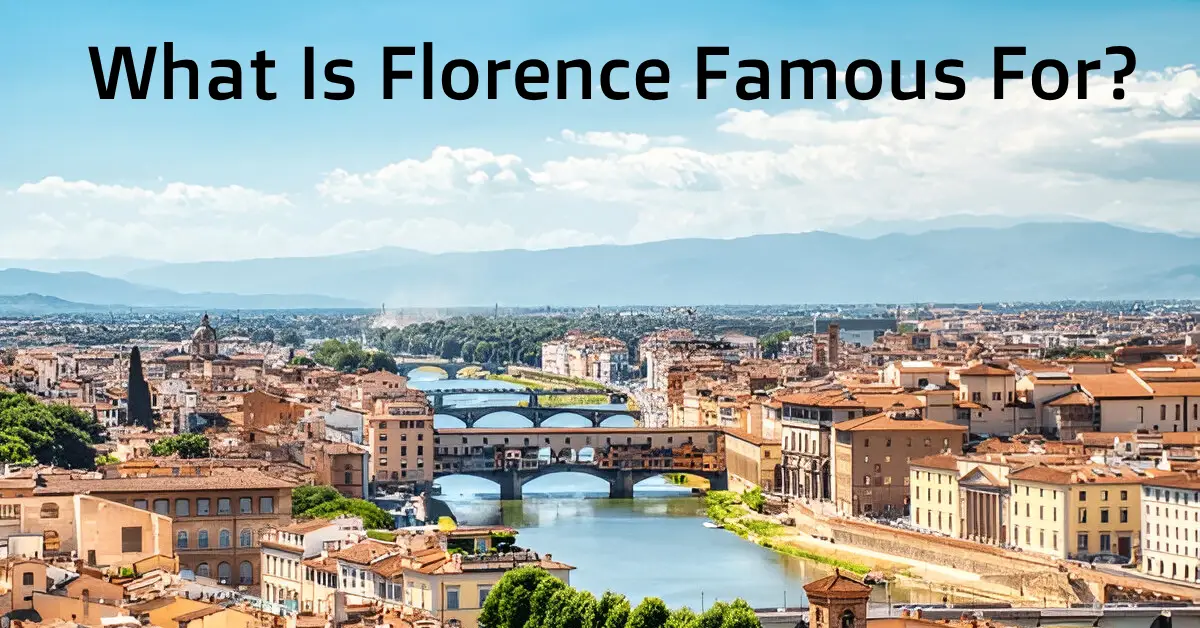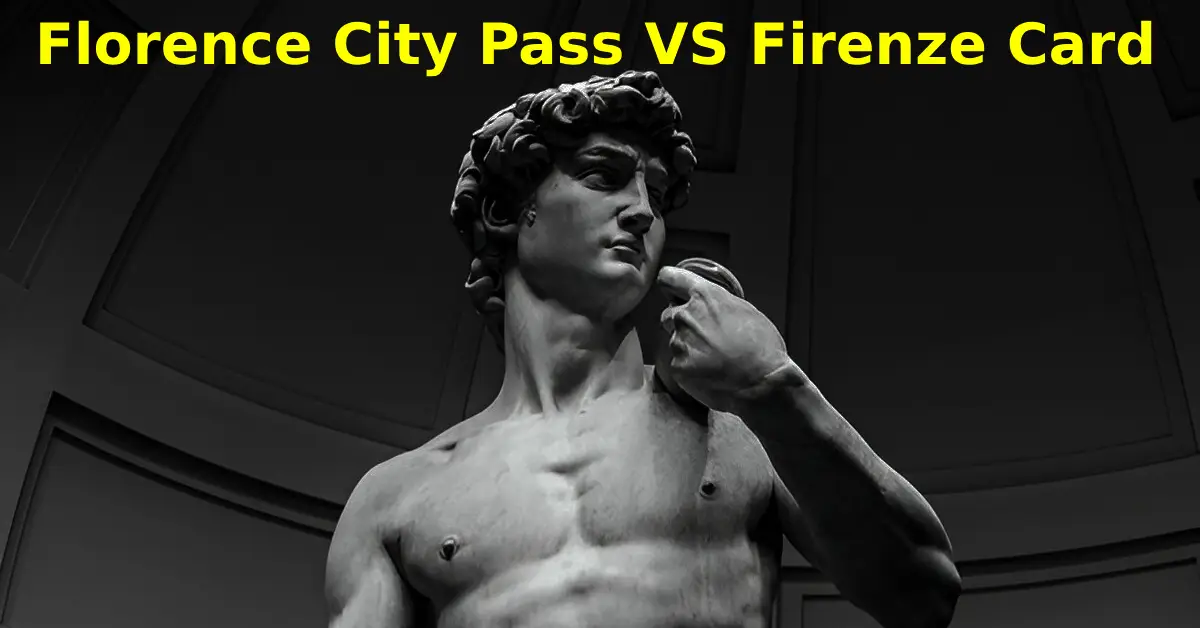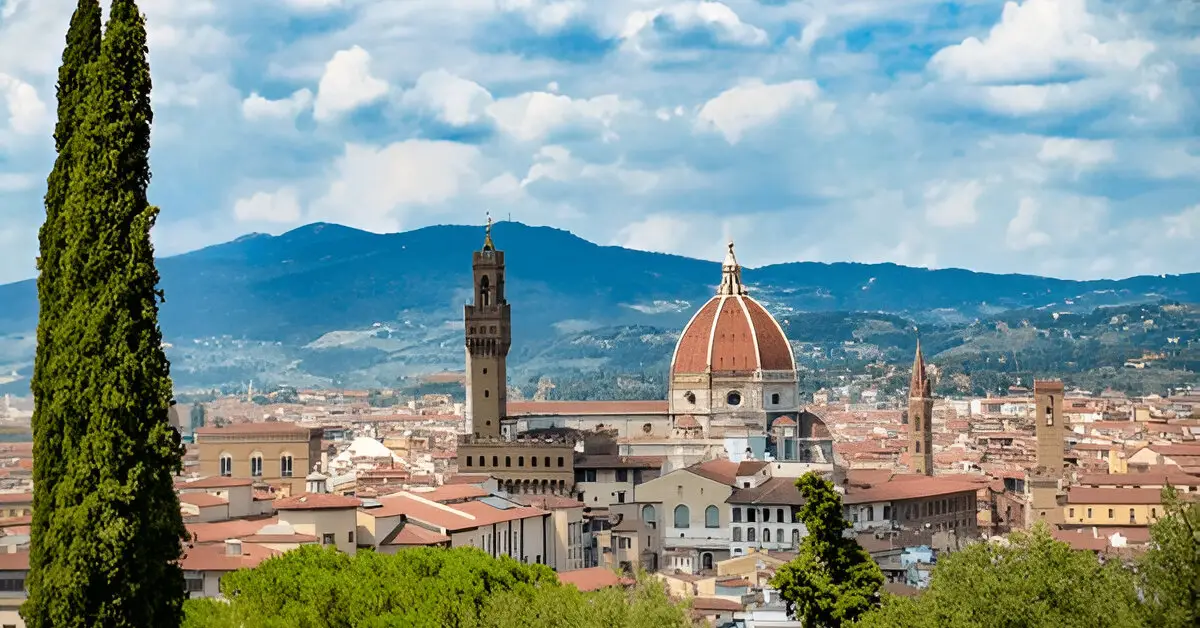Florence, the capital of Italy’s Tuscany region, stands as one of the world’s most culturally significant destinations and a testament to human artistic achievement. Known globally as the birthplace of the Renaissance, this enchanting city draws millions of visitors annually who come to experience its unparalleled collection of art, architecture, and cultural heritage. From world-renowned museums housing masterpieces by Michelangelo and Leonardo da Vinci to iconic architectural marvels like the Duomo and Ponte Vecchio, Florence offers an immersive journey through centuries of Italian history and artistic innovation.
The city’s compact historic center, designated as a UNESCO World Heritage Site, contains more artistic treasures per square kilometer than virtually any other place on Earth. Florence’s reputation as the cradle of the Renaissance extends beyond its museums and monuments to encompass its vibrant cultural traditions, exceptional cuisine, and the distinctive Tuscan lifestyle that continues to captivate visitors from around the globe. Whether you’re drawn by its artistic legacy, architectural splendor, culinary delights, or simply the romantic atmosphere of its cobblestone streets, Florence provides compelling reasons to visit that appeal to travelers of all interests and backgrounds.
Architecture
Florence’s architectural landscape represents one of the most impressive concentrations of Renaissance and medieval buildings in the world. The city’s skyline is dominated by iconic structures that have defined Western architectural traditions for centuries, making it a living museum of architectural evolution and artistic achievement.
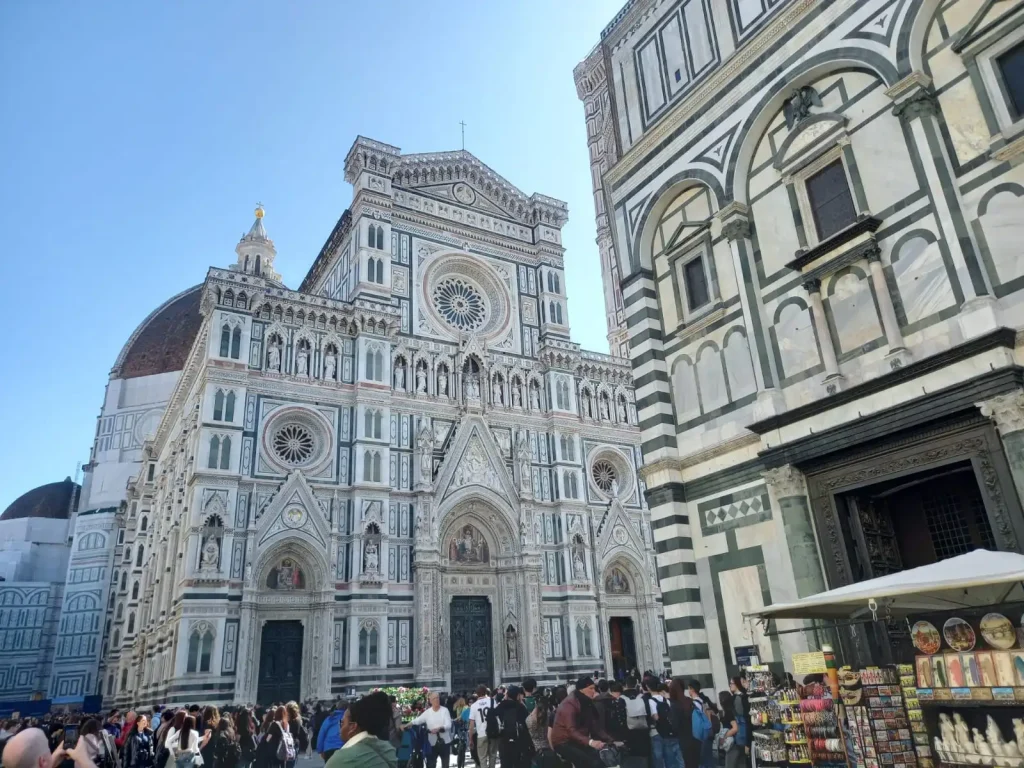
The magnificent Duomo, officially known as the Cathedral of Santa Maria del Fiore, stands as Florence’s most recognizable landmark and architectural masterpiece. Filippo Brunelleschi’s revolutionary dome, completed in 1436, remains an engineering marvel that continues to inspire architects today. The cathedral’s intricate Gothic Revival facade, adorned with pink, white, and green marble, creates a stunning visual spectacle that captures the essence of Florentine artistic excellence. Visitors can climb the 463 steps to the dome’s top for breathtaking panoramic views of the city and surrounding Tuscan countryside.
Adjacent to the Duomo, Giotto’s Campanile rises 84 meters into the sky, showcasing exquisite Gothic architecture with its polychrome marble decorations and intricate sculptural details. The bell tower, completed in 1359, demonstrates the sophisticated artistic vision that characterized Florence during its golden age. The nearby Baptistery of San Giovanni, with its famous bronze doors known as the “Gates of Paradise” created by Lorenzo Ghiberti, completes this architectural trinity that forms the heart of Florence’s religious and artistic identity.
The Palazzo Vecchio dominates Piazza della Signoria with its imposing fortress-like structure and distinctive tower. This 14th-century palace served as the seat of Florentine government and continues to function as the city’s town hall. Its medieval architecture, characterized by rusticated stonework and crenellated battlements, reflects the political power and civic pride that drove Florence’s remarkable cultural achievements. The palace’s interior houses magnificent frescoed halls and chambers that showcase the work of prominent Renaissance artists.
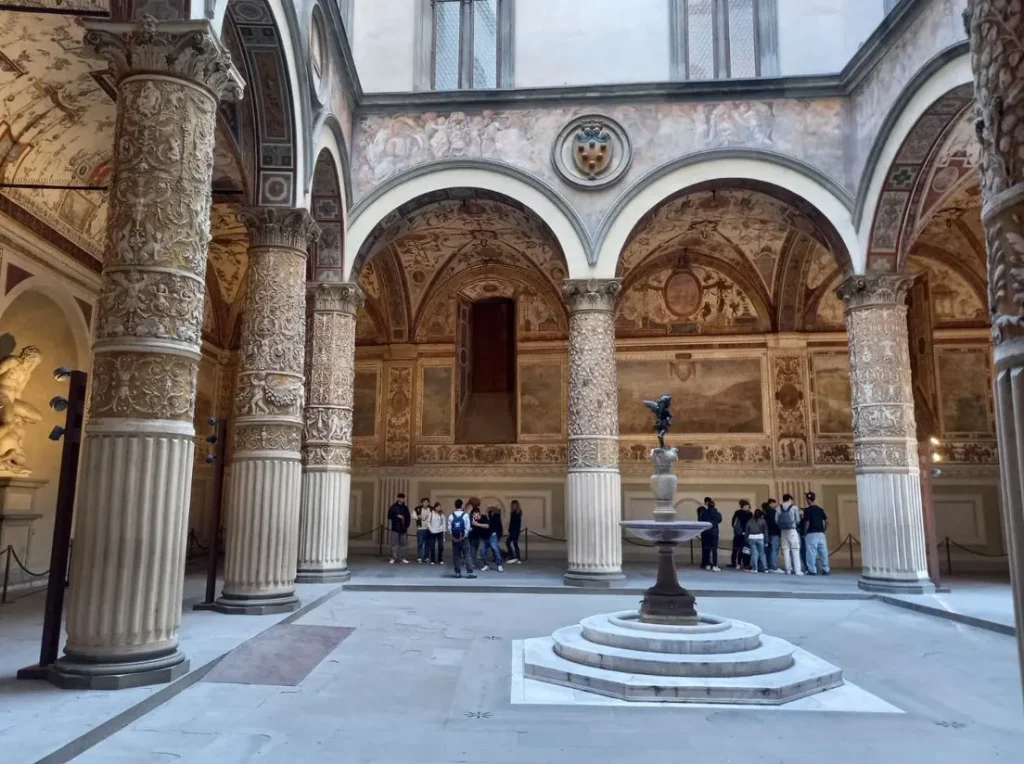
The Palazzo Pitti, originally built for the influential Pitti family in the 15th century, represents another architectural triumph that later became the residence of the powerful Medici dynasty. This massive Renaissance palace, with its distinctive rusticated facade and symmetrical design, houses several important museums and galleries. The palace’s architectural significance extends to the beautiful Boboli Gardens, which demonstrate Italian Renaissance garden design principles and provide a peaceful retreat from the city’s bustling streets.
The iconic Ponte Vecchio, spanning the Arno River, stands as one of Europe’s most photographed bridges and a symbol of Florence’s enduring appeal. This medieval stone bridge, lined with jewelry shops and goldsmith workshops, has survived floods, wars, and centuries of urban development. Its unique architecture, featuring shops built directly into the bridge structure, creates a distinctive silhouette that has become synonymous with Florence’s romantic character and commercial heritage.
Cultural Traditions
Florence’s cultural traditions reflect centuries of artistic innovation, religious devotion, and civic pride that continue to shape the city’s identity and attract visitors seeking authentic Italian cultural experiences. These traditions encompass everything from religious festivals and artistic practices to social customs and educational heritage that have influenced Western civilization.
The city’s Renaissance heritage permeates every aspect of its cultural life, from the continuing tradition of artisan craftsmanship to the preservation of historical painting and sculpture techniques. Florence remains home to numerous workshops where skilled artisans practice traditional methods of creating leather goods, jewelry, textiles, and decorative arts. These workshops, many of which have operated for generations, maintain the artistic standards and techniques that made Florence famous throughout Europe during the Renaissance period.
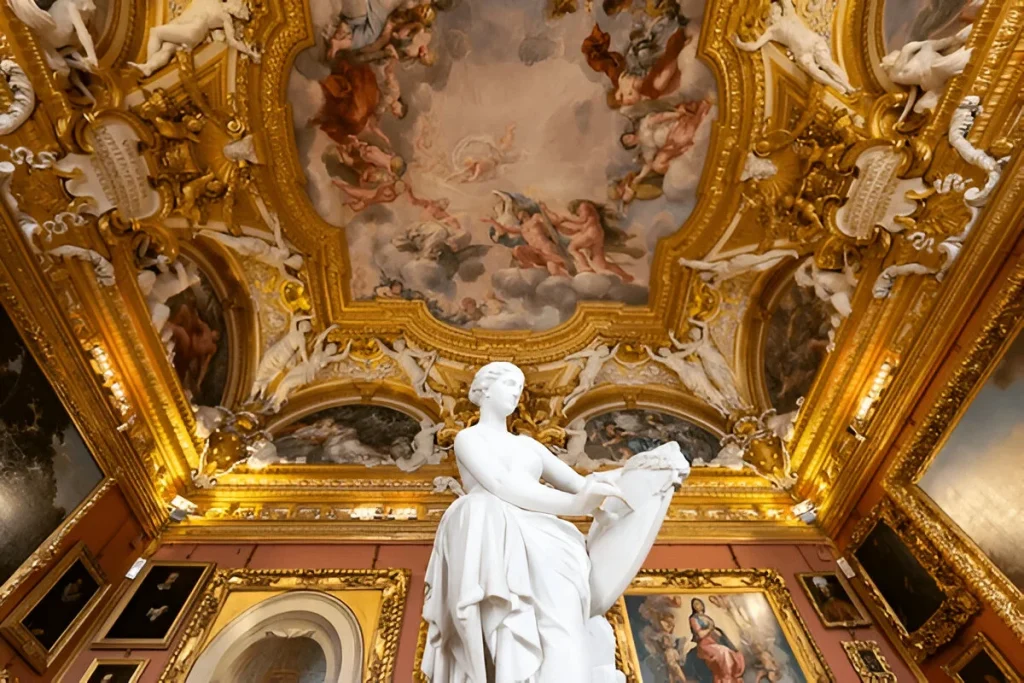
Religious traditions play a significant role in Florentine cultural life, with numerous festivals and celebrations throughout the year that combine spiritual observance with spectacular public displays. The Scoppio del Carro, or “Explosion of the Cart,” takes place each Easter Sunday in front of the Duomo, featuring an elaborate fireworks display that dates back to the Crusades. This unique celebration demonstrates the city’s ability to blend religious devotion with theatrical spectacle, creating memorable experiences that connect visitors to centuries of cultural continuity.
The Calcio Storico, Florence’s historic football tournament, represents one of the city’s most distinctive cultural traditions. This brutal medieval sport, played each June in Piazza Santa Croce, combines elements of soccer, rugby, and wrestling in a competition between the city’s four historical districts. The tournament, which dates back to the 16th century, showcases Florentine neighborhood pride and community spirit while providing visitors with insight into the city’s competitive and passionate character.
Florence’s intellectual and educational traditions continue through institutions like the Accademia di Belle Arti, one of the world’s oldest art academies, and numerous cultural organizations that promote artistic education and cultural preservation. The city’s libraries, including the historic Laurentian Library designed by Michelangelo, maintain extensive collections of manuscripts and books that document centuries of intellectual achievement and cultural development.
The tradition of the passeggiata, the evening stroll through the city’s historic streets and piazzas, reflects the social customs that make Florence a particularly appealing destination for visitors seeking to experience authentic Italian lifestyle. This daily ritual, combined with the city’s cafe culture and outdoor dining traditions, creates opportunities for cultural immersion that extend beyond museum visits and architectural tours.
Contemporary cultural traditions in Florence include numerous festivals, concerts, and exhibitions that celebrate both historical heritage and modern artistic expression. The Maggio Musicale Fiorentino, one of Italy’s most prestigious music festivals, continues the city’s tradition of supporting performing arts while attracting international audiences to experience world-class musical performances in historic venues.
Florentine Food
Florence’s culinary heritage represents a perfect marriage of Tuscan agricultural traditions and sophisticated urban dining culture, creating a food scene that attracts gourmets and casual diners alike. The city’s restaurants, markets, and food traditions offer authentic experiences that showcase the best of Italian cuisine while maintaining distinctive regional characteristics that reflect centuries of local culinary development.
Traditional Florentine cuisine emphasizes high-quality ingredients prepared with simple techniques that highlight natural flavors and seasonal availability. The famous Bistecca alla Fiorentina, a thick-cut T-bone steak from Chianina cattle, represents the pinnacle of Florentine meat dishes. This substantial steak, typically shared between two diners, is grilled over chestnut wood and seasoned only with salt, pepper, and olive oil, demonstrating the Tuscan philosophy of allowing superior ingredients to speak for themselves.
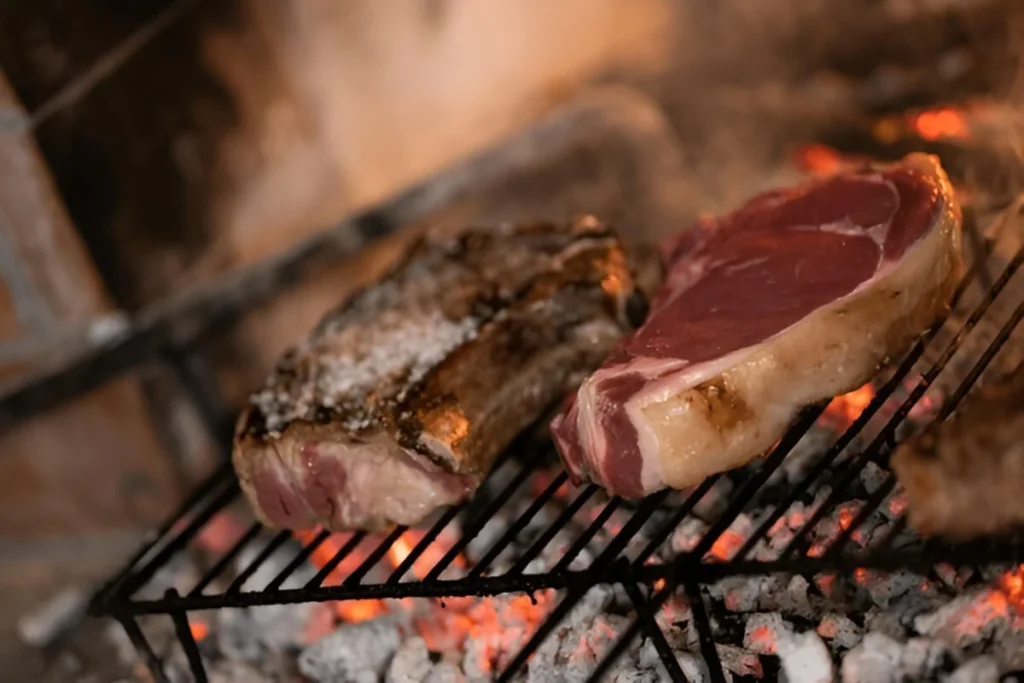
Ribollita, literally meaning “reboiled,” stands as Florence’s most iconic soup and a perfect example of traditional Tuscan peasant cuisine elevated to culinary art. This hearty vegetable soup, made with white beans, kale, cabbage, and day-old bread, reflects the resourceful cooking traditions that emerged from Tuscany’s agricultural heritage. The soup’s rich flavors and satisfying texture make it a favorite among visitors seeking authentic Florentine comfort food.
Pappa al Pomodoro, another beloved Florentine dish, transforms simple ingredients—tomatoes, bread, garlic, basil, and olive oil—into a flavorful soup that captures the essence of Tuscan cooking. This dish, traditionally prepared during tomato harvest season, demonstrates how Florentine cuisine celebrates seasonal ingredients while creating memorable dining experiences from humble components.
Florence’s markets, particularly the historic Mercato Centrale, provide immersive experiences in local food culture while offering opportunities to taste authentic ingredients and prepared foods. The market’s ground floor features traditional vendors selling fresh produce, meats, cheeses, and specialty items, while the upper level houses modern food stalls and restaurants that blend traditional techniques with contemporary presentation.
The city’s bread traditions include the distinctive Tuscan bread, notable for its absence of salt, which pairs perfectly with the region’s flavorful olive oils and cured meats. This bread, along with traditional pastries and baked goods, reflects centuries-old recipes and techniques that continue to be practiced in neighborhood bakeries throughout Florence.
Florentine gelato represents another essential culinary experience, with numerous artisanal gelaterias creating fresh flavors daily using traditional methods and high-quality ingredients. The city’s gelato shops, ranging from historic establishments to innovative modern creators, offer visitors the opportunity to experience this beloved Italian dessert at its finest.
Wine culture plays a central role in Florentine dining, with local establishments offering extensive selections of Tuscan wines, including Chianti, Brunello di Montalcino, and Vino Nobile di Montepulciano. The tradition of the aperitivo, enjoyed in outdoor cafes and wine bars throughout the historic center, provides visitors with opportunities to experience local social customs while enjoying high-quality wines and light snacks.
The city’s olive oil heritage contributes significantly to its culinary reputation, with restaurants and shops offering tastings of premium extra virgin olive oils produced in the surrounding Tuscan countryside. These oils, characterized by their fruity flavors and peppery finish, enhance virtually every aspect of Florentine cuisine and provide visitors with authentic tastes of the regional terroir.
Contemporary Florentine dining includes innovative restaurants that reinterpret traditional dishes while maintaining respect for local ingredients and cooking traditions. These establishments, often run by young chefs trained in classical techniques, create modern expressions of Tuscan cuisine that appeal to international palates while preserving the essential characteristics that make Florentine food distinctive and memorable.
Duomo Cathedral
The Florence Duomo, officially known as the Cattedrale di Santa Maria del Fiore, represents the spiritual and architectural heart of Florence and stands as one of the most magnificent examples of Gothic architecture in Italy. This extraordinary religious complex, comprising the cathedral itself, Brunelleschi’s iconic dome, and the adjacent bell tower and baptistery, attracts millions of visitors annually who come to witness its architectural splendor and historical significance.
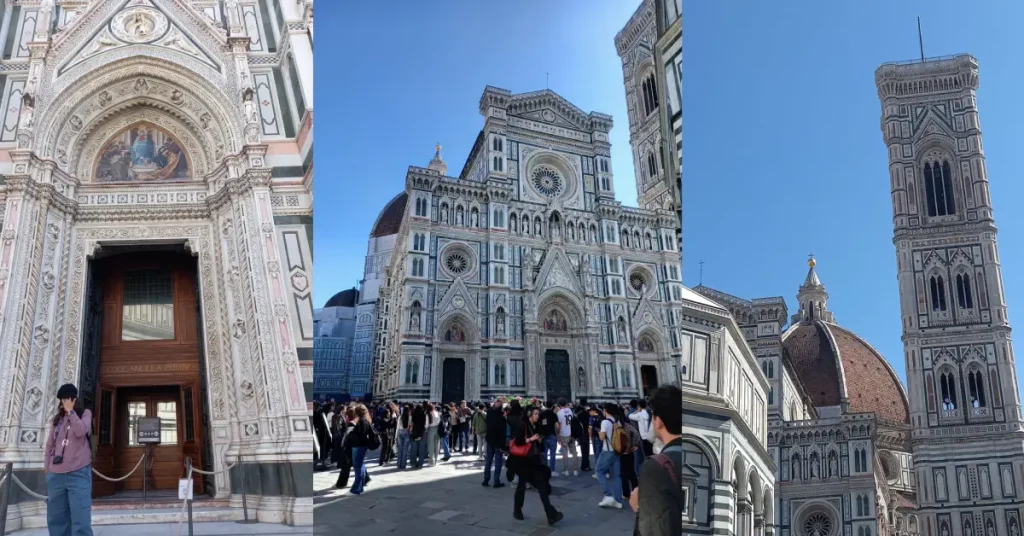
Brunelleschi’s dome, completed in 1436, remains an engineering masterpiece that revolutionized Renaissance architecture and continues to inspire architects and engineers today. The massive octagonal dome, constructed without traditional wooden supports, demonstrates innovative engineering techniques that were considered impossible by contemporary standards. Visitors can ascend the 463 steps through the dome’s interior corridors to reach the lantern, where breathtaking panoramic views of Florence and the surrounding Tuscan landscape await.
The cathedral’s facade, completed in the 19th century, showcases intricate Gothic Revival architecture adorned with pink, white, and green Carrara marble that creates a stunning polychromatic effect. The detailed sculptural work, featuring biblical scenes and religious figures, demonstrates the exceptional craftsmanship that characterizes Florence’s architectural heritage. The massive bronze doors, crafted by renowned artists, provide impressive entrances that complement the building’s overall grandeur. Book your Duomo tickets in advance to skip the line and climb to the top.
Uffizi Gallery
The Uffizi Gallery stands as one of the world’s most prestigious art museums and houses the most comprehensive collection of Renaissance masterpieces ever assembled under one roof. Originally constructed in the 16th century as government offices for the Medici family, this U-shaped building was transformed into a public museum that now attracts art enthusiasts from around the globe seeking to experience humanity’s greatest artistic achievements.
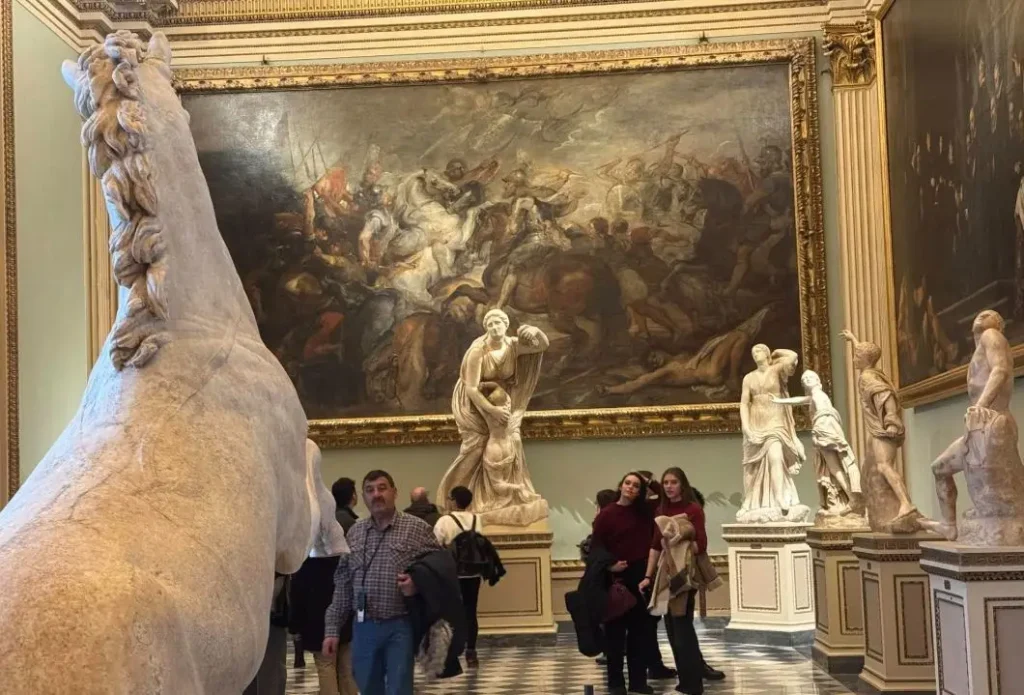
The gallery’s collection includes iconic works by Leonardo da Vinci, Michelangelo, Raphael, Botticelli, and countless other Renaissance masters whose paintings and sculptures defined Western artistic traditions. Botticelli’s “The Birth of Venus” and “Primavera” represent some of the most recognizable artworks in human history, while Leonardo’s “The Annunciation” demonstrates the technical mastery that made him a Renaissance genius.
The museum’s chronologically arranged galleries provide visitors with a comprehensive journey through the evolution of Italian art from the medieval period through the High Renaissance. Each room contains carefully curated collections that demonstrate artistic developments, stylistic changes, and the cultural context that influenced these masterpieces. The gallery’s architecture itself, with its long corridors and systematic organization, creates an ideal environment for experiencing these treasures.
Accademia Gallery
The Accademia Gallery, officially known as the Galleria dell’Accademia di Firenze, houses Florence’s most famous sculpture and serves as a pilgrimage destination for art lovers seeking to experience Michelangelo’s artistic genius firsthand. This museum, originally established as an educational institution for fine arts students, now provides public access to some of the most important sculptures in Western art history.

Michelangelo’s “David,” completed between 1501 and 1504, stands as the gallery’s centerpiece and arguably the most famous sculpture in the world. This 17-foot marble masterpiece, originally commissioned for Florence’s cathedral, demonstrates Michelangelo’s extraordinary ability to transform stone into lifelike human form. The sculpture’s perfect proportions, anatomical accuracy, and emotional intensity continue to inspire viewers more than 500 years after its creation.
The gallery also houses Michelangelo’s “Prisoners” or “Slaves,” a series of unfinished sculptures that provide insight into the artist’s creative process and demonstrate his belief that sculptures already existed within the marble, waiting to be released. These works, along with other Renaissance sculptures and paintings, create a comprehensive collection that illustrates the artistic achievements of Florence’s golden age.
Santa Croce
The Basilica of Santa Croce represents one of Florence’s most significant religious and cultural landmarks, serving as both a place of worship and a repository of Renaissance art that attracts visitors seeking to experience the intersection of spirituality and artistic achievement. This Franciscan church, known as the “Temple of Italian Glories,” houses the tombs of Michelangelo, Galileo, Machiavelli, and other luminaries who shaped Western civilization.

The basilica’s interior features magnificent frescoes by Giotto in the Bardi and Peruzzi chapels, which revolutionized medieval painting by introducing naturalistic human figures and emotional depth that would influence Renaissance art for centuries. These 14th-century masterpieces demonstrate the artistic innovations that established Florence as the birthplace of Renaissance painting and continue to inspire contemporary artists and art historians.
The church’s Gothic architecture, characterized by its soaring vaults, elegant columns, and harmonious proportions, creates a spiritual atmosphere that enhances the viewing experience of its artistic treasures. The wooden crucifix by Donatello, chapel decorations by Brunelleschi, and numerous other artworks make Santa Croce a comprehensive museum of Renaissance religious art.
Medici Chapels
The Medici Chapels, part of the Basilica of San Lorenzo, serve as the mausoleum of the powerful Medici family and showcase some of Michelangelo’s most important sculptural works in an intimate setting that reflects the family’s wealth, power, and artistic patronage. These sacred spaces, including the New Sacristy designed by Michelangelo and the opulent Chapel of the Princes, demonstrate the intersection of religious devotion, political power, and artistic excellence.
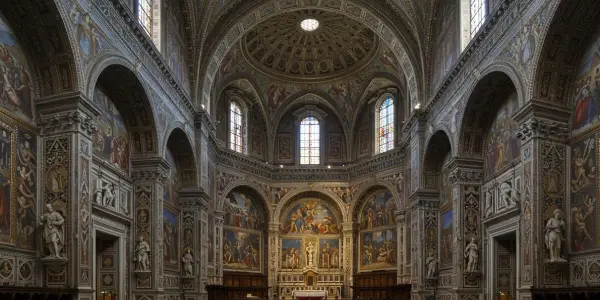
Michelangelo’s sculptural masterpieces in the New Sacristy, including the tombs of Lorenzo the Magnificent’s son and grandson, feature allegorical figures representing Day, Night, Dawn, and Dusk that rank among the artist’s most sophisticated works. The architectural design, also by Michelangelo, creates a harmonious environment where sculpture and architecture work together to create a unified artistic experience.
The Chapel of the Princes, covered in precious stones and marble inlays, demonstrates the extraordinary wealth and artistic taste of the Medici dynasty. This octagonal chapel, with its massive dome and elaborate decorations, serves as a testament to the family’s commitment to artistic patronage and their desire to create lasting monuments to their legacy.
Ponte Vecchio
The Ponte Vecchio stands as Florence’s most iconic bridge and one of Europe’s most photographed landmarks, representing centuries of commercial tradition and architectural innovation that continues to captivate visitors with its unique character and romantic atmosphere. This medieval stone bridge, spanning the Arno River at its narrowest point, has survived floods, wars, and urban development while maintaining its distinctive appearance and commercial function.
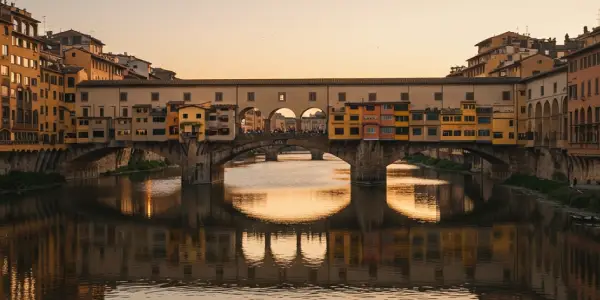
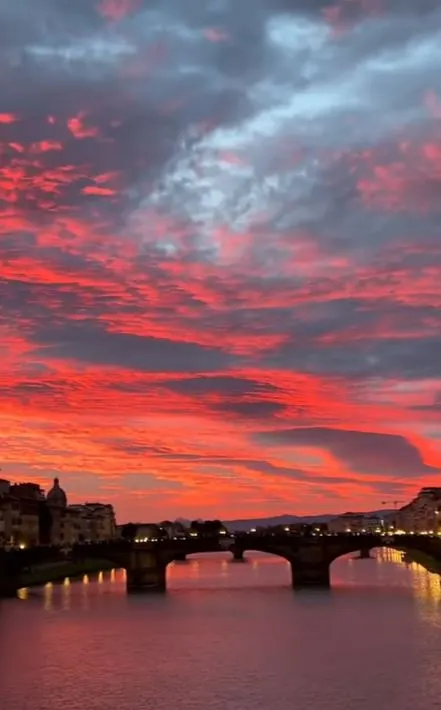
The bridge’s most remarkable feature is its shops built directly into the structure, a medieval practice that creates a unique shopping experience found nowhere else in the world. Originally occupied by butchers and tanners, these shops now house goldsmiths and jewelry makers who continue centuries-old traditions of Florentine craftsmanship. The Vasari Corridor, a covered passageway above the shops, was built to allow the Medici family to travel between their residences without mixing with common citizens.
The bridge’s three arches, constructed from local stone, demonstrate medieval engineering techniques that have withstood the test of time and continue to support both the structure and its commercial activities. The central span, wider than the others, provides space for the shops while maintaining the bridge’s structural integrity and creating the distinctive silhouette that has become synonymous with Florence.
Michelangelo David Statue
Michelangelo’s David, housed in the Accademia Gallery, represents the pinnacle of Renaissance sculptural achievement and stands as a symbol of artistic perfection that continues to inspire and amaze visitors from around the world. This 17-foot marble masterpiece, carved from a single block of Carrara marble between 1501 and 1504, demonstrates Michelangelo’s extraordinary technical skill and artistic vision that transformed Renaissance art.
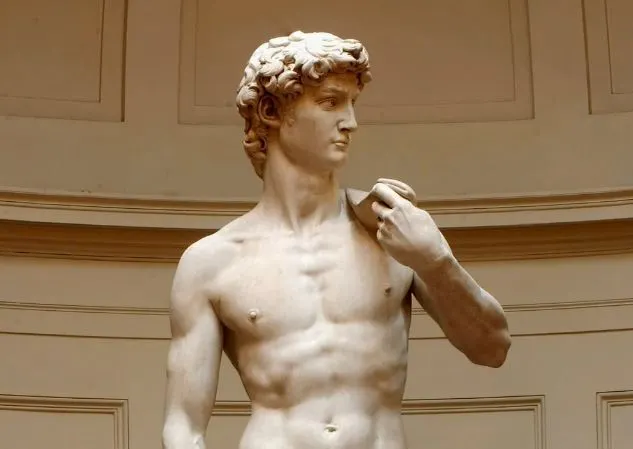
The sculpture depicts the biblical hero David before his battle with Goliath, capturing a moment of contemplation and determination that reveals both physical strength and psychological complexity. Michelangelo’s anatomical accuracy, achieved through careful study of human cadavers, creates a lifelike figure that seems to breathe with life and emotion. The sculpture’s perfect proportions, muscular detail, and facial expression demonstrate the artist’s ability to convey both physical beauty and spiritual depth.
The statue’s creation story reflects the political climate of Renaissance Florence, where David symbolized the city’s republican values and resistance to more powerful enemies. Originally intended for the cathedral’s roofline, the sculpture’s artistic merit led to its placement in front of the Palazzo Vecchio, where it served as a symbol of Florentine independence and civic pride until being moved to the Accademia for preservation.
Boboli Gardens
The Boboli Gardens represent one of Europe’s finest examples of Italian Renaissance garden design and provide a peaceful retreat from Florence’s bustling streets while showcasing centuries of landscape architecture and artistic integration. These formal gardens, created for the Medici family behind the Pitti Palace, demonstrate the Renaissance ideal of harmonizing nature and art through carefully planned spaces that enhance both natural beauty and human creativity.
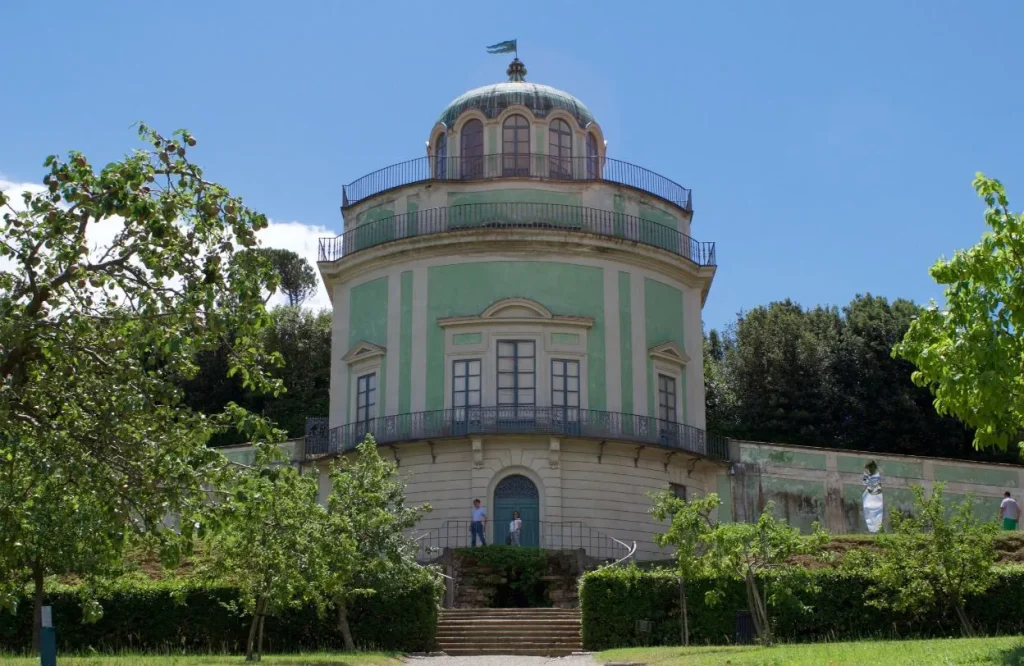
The gardens’ design incorporates classical elements including geometric patterns, symmetrical layouts, terraced levels, and strategic viewpoints that create a series of outdoor rooms connected by pathways, stairs, and water features. Ancient Roman statues, Renaissance sculptures, and baroque fountains are strategically placed throughout the gardens to create focal points that enhance the overall aesthetic experience while providing opportunities for contemplation and discovery.
The amphitheater, carved into the hillside behind the palace, hosts outdoor performances and provides spectacular views of Florence’s skyline and the surrounding Tuscan countryside. The gardens’ grotto, designed by Bernardo Buontalenti, features elaborate decorations and artificial stalactites that demonstrate Renaissance fascination with combining natural and artificial elements in surprising and delightful ways.
Leonardo Da Vinci
Leonardo da Vinci’s connection to Florence extends far beyond his famous artworks housed in the city’s museums, encompassing his formative years as an artist, his scientific investigations, and his lasting influence on Renaissance culture that continues to attract visitors seeking to understand this remarkable genius. Florence provided the intellectual environment where Leonardo developed his artistic skills, scientific curiosity, and innovative approach to understanding the natural world.
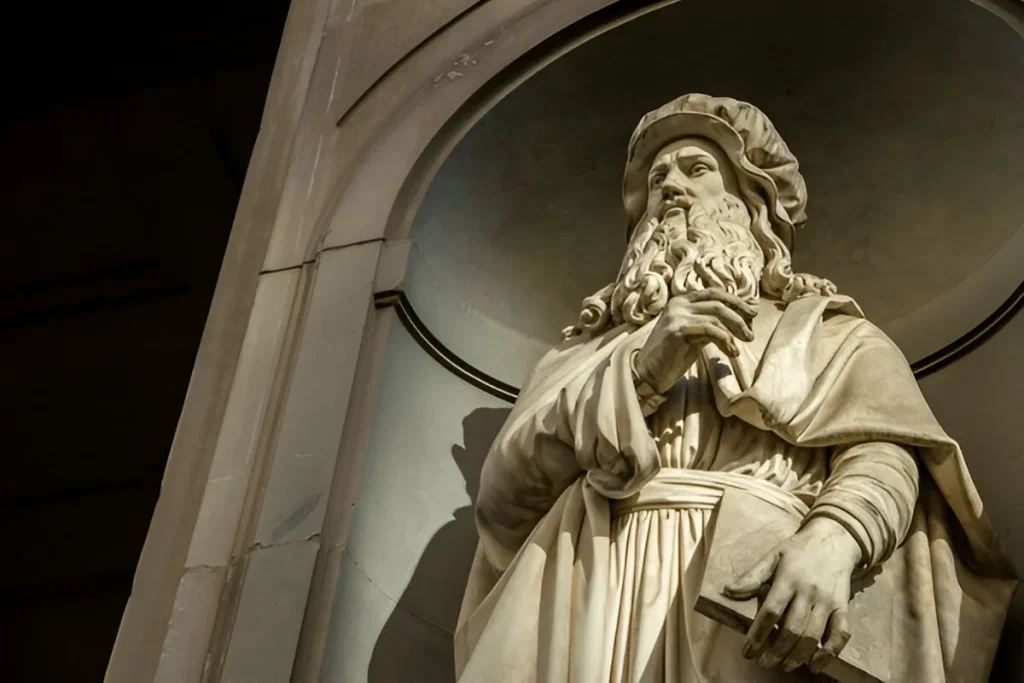
The city’s museums house several of Leonardo’s important works, including “The Annunciation” at the Uffizi Gallery, which demonstrates his mastery of perspective, anatomical accuracy, and atmospheric effects that would influence generations of artists. His unfinished painting “Saint Jerome in the Wilderness,” also in the Vatican Museums but with strong Florence connections, shows his innovative painting techniques and psychological insight that made him unique among Renaissance artists.
Leonardo’s scientific manuscripts and drawings, many of which were created during his time in Florence, reveal his investigations into anatomy, engineering, botany, and physics that were centuries ahead of their time. The city’s libraries and museums preserve examples of his mirror writing, technical drawings, and observational studies that demonstrate the integration of artistic and scientific thinking that characterized Renaissance humanism and continue to inspire contemporary scholars and artists.
Barchetti River Boats
The Barchetti, traditional wooden boats that once navigated the Arno River, represent an often-overlooked aspect of Florence’s maritime heritage and transportation history. These flat-bottomed vessels played a crucial role in the city’s commercial development, carrying goods and passengers along the river that served as Florence’s primary trade route for centuries. While modern transportation has largely replaced these traditional boats, their historical significance continues to fascinate visitors interested in understanding how Florence evolved as a major European trading center.
These boats were specifically designed to navigate the Arno’s shallow waters and seasonal variations, featuring distinctive construction techniques that reflected local craftsmanship and practical maritime knowledge. The skilled boatmen who operated these vessels developed specialized techniques for navigating the river’s currents, bridges, and varying water levels throughout the year. During Florence’s golden age, these boats transported everything from raw materials for textile production to finished goods destined for markets throughout Europe.
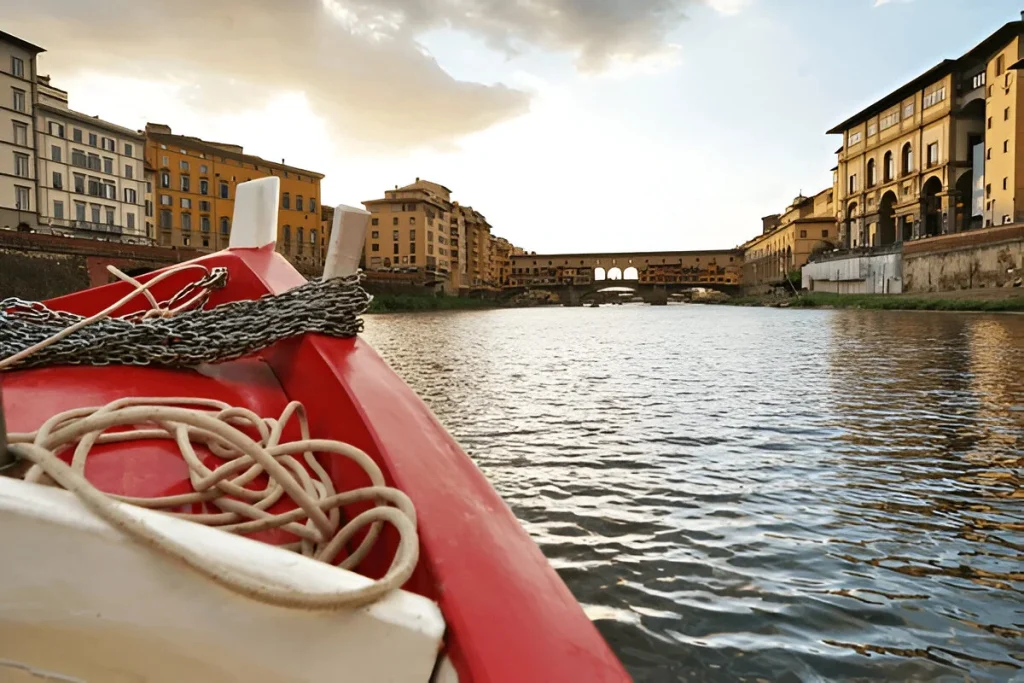
Today, visitors can still see examples of traditional Barchetti construction and learn about their role in Florentine commerce through museum exhibits and historical demonstrations. The boats’ influence on Florence’s development as a trading power helps explain how this inland city became one of Europe’s wealthiest and most influential centers during the Renaissance period.
Leather-Made Products
Florence’s leather craftsmanship tradition spans over eight centuries and continues to attract discerning shoppers from around the world who seek authentic Italian leather goods made using time-honored techniques. The city’s leather artisans, concentrated primarily in the Oltrarno district and around the San Lorenzo market area, maintain workshops where skilled craftspeople create handbags, shoes, jackets, and accessories that exemplify the quality and style associated with Florentine manufacturing.

The leather working tradition began during the medieval period when Florence’s location along major trade routes provided access to high-quality hides from throughout Europe and beyond. Local artisans developed distinctive techniques for tanning, dying, and working leather that produced exceptionally durable and beautiful products. These skills were passed down through generations of craftspeople who refined their methods while maintaining the essential characteristics that made Florentine leather goods highly sought after.
Modern visitors can explore numerous leather workshops and boutiques throughout Florence’s historic center, where traditional techniques are still practiced alongside contemporary designs. The Mercato Centrale and surrounding streets offer opportunities to watch artisans at work, creating custom pieces that demonstrate the intersection of traditional craftsmanship and modern fashion sensibilities. Many workshops offer personalization services, allowing visitors to create unique leather goods that serve as lasting mementos of their Florence experience.
Piazza della Signoria
Piazza della Signoria serves as Florence’s political and cultural heart, providing a magnificent open-air sculpture gallery that showcases the city’s artistic heritage while functioning as a vibrant public space where locals and visitors gather to experience the essence of Florentine civic life. This L-shaped piazza, dominated by the imposing Palazzo Vecchio, has witnessed centuries of political drama, public celebrations, and artistic achievements that shaped Florence’s identity as a center of Renaissance culture.
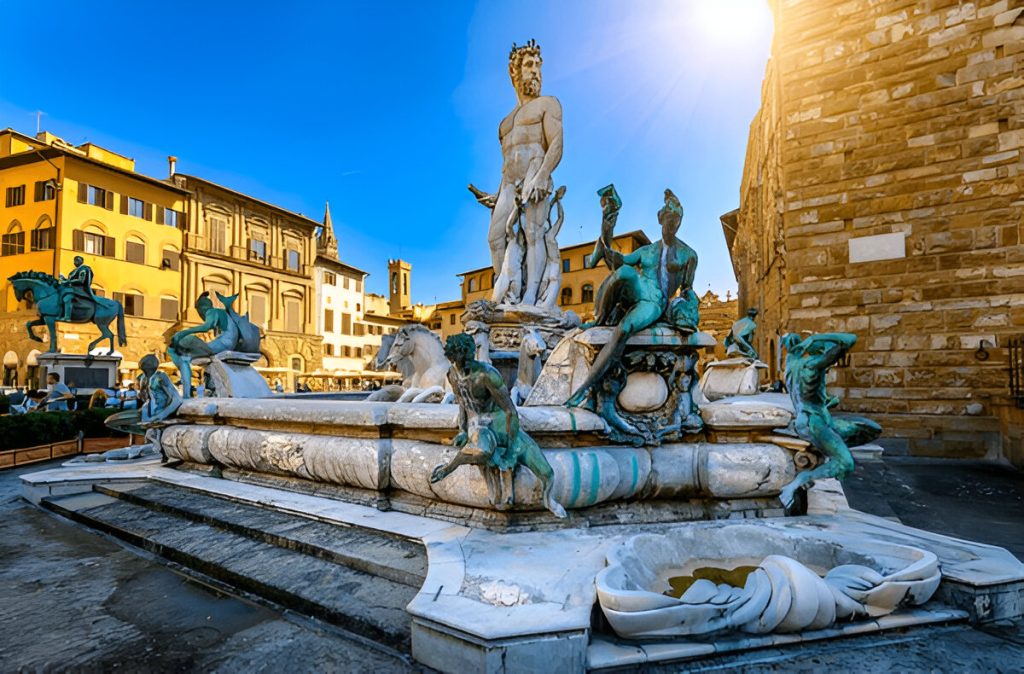
The piazza’s most famous feature is the Fountain of Neptune, created by Bartolomeo Ammannati in the 16th century, which demonstrates the Mannerist style that followed the High Renaissance. Local Florentines affectionately call this massive marble sculpture “Biancone” (the big white one), and it serves as a popular meeting point for both tourists and residents. The fountain’s classical mythology and elaborate design reflect the sophisticated artistic tastes of the Medici court and their desire to create public artworks that enhanced the city’s grandeur.
The Loggia dei Lanzi, an open-air sculpture gallery adjacent to the Palazzo Vecchio, houses masterpieces including Cellini’s bronze “Perseus with the Head of Medusa” and Giambologna’s “Rape of the Sabine Women.” These sculptures, displayed in an architectural setting that protects them from the elements while allowing public access, create a unique museum experience that integrates art with daily life in ways that few other cities can match.
Palazzo Vecchio
Palazzo Vecchio stands as Florence’s town hall and a symbol of the city’s republican government, housing centuries of political history within its fortress-like walls while serving as a magnificent example of medieval civic architecture. This imposing 14th-century palace, with its distinctive crenellated tower rising 94 meters above the piazza, continues to function as Florence’s seat of government while offering visitors access to some of the most beautifully decorated rooms in Italy.
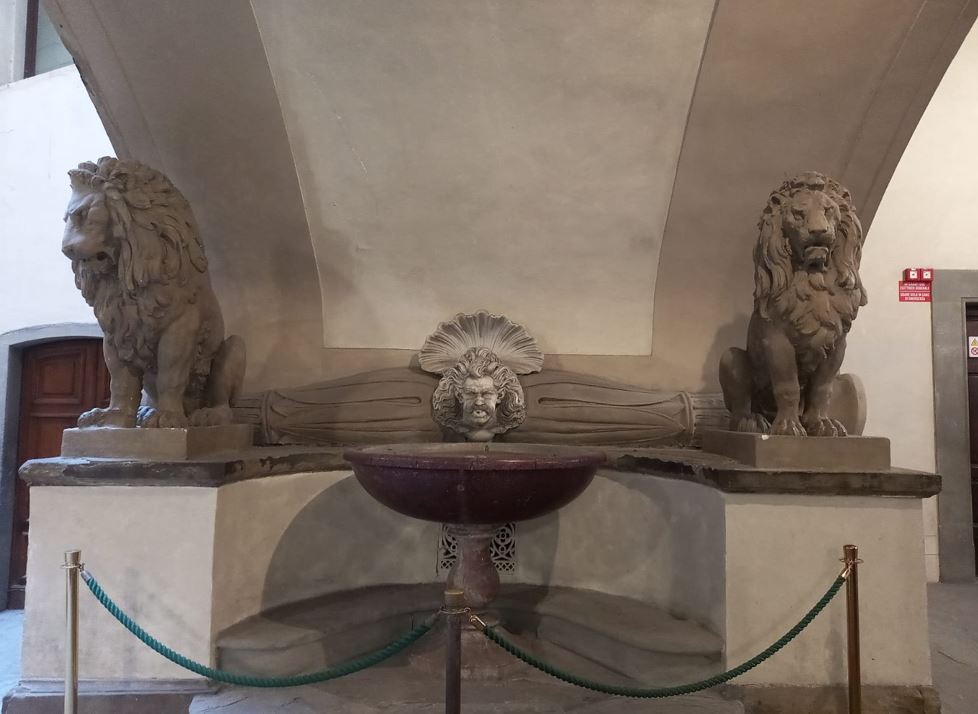
The palace’s interior features the magnificent Salone dei Cinquecento, a vast hall created by Savonarola for the city’s Grand Council and later decorated by Giorgio Vasari with frescoes celebrating Florentine military victories. The room’s impressive scale and elaborate decorations demonstrate the civic pride and artistic sophistication that characterized Renaissance Florence. Leonardo da Vinci and Michelangelo were originally commissioned to create competing frescoes for this hall, though their works were never completed.
The palace’s private apartments, once occupied by Cosimo I de’ Medici and his family, showcase the luxurious lifestyle of Florence’s ruling class through elaborate frescoes, intricate ceiling decorations, and period furnishings that transport visitors to the height of Medici power. The palace’s tower offers spectacular views of Florence’s skyline and the surrounding Tuscan countryside, providing a unique perspective on the city’s architectural harmony and natural setting.
Church of San Lorenzo
The Church of San Lorenzo, one of Florence’s oldest churches and the parish church of the powerful Medici family, represents a masterpiece of Renaissance architecture and houses some of the most important artistic treasures in the city. Designed by Filippo Brunelleschi in the 15th century, this basilica demonstrates the architect’s revolutionary approach to church design and his mastery of classical proportions that influenced religious architecture throughout Europe.

The church’s interior, characterized by its harmonious proportions and innovative use of pietra serena (gray stone) architectural elements, creates a sense of mathematical perfection that reflects Renaissance ideals of beauty and spiritual harmony. Brunelleschi’s design innovations, including the use of classical columns and arches, marked a departure from Gothic traditions and established new standards for church architecture that would be emulated for centuries.
The church houses important artworks including Donatello’s bronze pulpits, his final works that demonstrate the artist’s mature style and emotional intensity. The Laurentian Library, designed by Michelangelo and attached to the church, contains one of the world’s most important collections of ancient manuscripts and demonstrates the Medici family’s commitment to learning and cultural preservation. The library’s reading room and innovative staircase design showcase Michelangelo’s architectural genius and his ability to create functional spaces that are also works of art.
Why You Should Visit Florence Italy?
Florence offers an unparalleled concentration of artistic, architectural, and cultural treasures that make it one of the world’s most rewarding travel destinations. Here are the top reasons why Florence should be on every traveler’s bucket list:
- Unmatched Renaissance Art Collection: Florence houses the world’s most comprehensive collection of Renaissance masterpieces, from Michelangelo’s David to Botticelli’s Birth of Venus, offering visitors the opportunity to see humanity’s greatest artistic achievements in their original context.
- Architectural Marvels: The city’s skyline, dominated by Brunelleschi’s revolutionary dome and punctuated by medieval towers and Renaissance palaces, creates a visual experience that transports visitors to one of history’s most creative periods.
- Authentic Italian Culture: Florence maintains its authentic Italian character while welcoming international visitors, providing opportunities to experience genuine Tuscan lifestyle, from morning coffee rituals to evening aperitivo traditions.
- Culinary Excellence: The city’s restaurants, markets, and food traditions offer exceptional dining experiences that showcase both traditional Tuscan cuisine and innovative contemporary interpretations of classic dishes.
- Walkable Historic Center: Florence’s compact size makes it perfect for exploring on foot, allowing visitors to discover hidden gems, stumble upon masterpieces, and experience the city’s rhythm at a leisurely pace.
What Products is Florence Famous For?
Florence has developed an international reputation for producing luxury goods and artisanal products that combine traditional craftsmanship with contemporary design sensibilities. The city’s manufacturing heritage spans centuries and continues to attract discerning consumers seeking authentic Italian quality.
Leather Goods: Florentine leather artisans create handbags, shoes, jackets, and accessories that are renowned worldwide for their quality, durability, and elegant design. The city’s leather workshops, particularly in the Oltrarno district, maintain traditional techniques while incorporating modern styles.
Gold and Silver Jewelry: The Ponte Vecchio and surrounding areas house numerous jewelry workshops where skilled goldsmiths create both traditional and contemporary pieces using techniques passed down through generations of Florentine craftsmen.
Textiles and Fashion: Florence’s textile industry, which dates back to the medieval period, continues to produce high-quality fabrics and fashion items that reflect the city’s sophisticated aesthetic sensibilities and attention to detail.
Artisanal Paper Products: Florentine bookbinders and paper makers create beautiful handmade books, stationery, and decorative items using traditional techniques that produce unique, high-quality products.
Perfumes and Cosmetics: The city’s perfumeries, some dating back centuries, create distinctive fragrances and beauty products that capture the essence of Tuscan ingredients and Italian style.
Is Florence Safe For Tourists?
Florence maintains excellent safety standards for tourists and ranks among Europe’s safest major cities for international visitors. The city’s low crime rates, efficient emergency services, and tourist-friendly infrastructure create a secure environment for travelers of all ages and backgrounds.
Violent crime and scams against tourists is extremely rare in Florence, with most safety concerns limited to petty theft and pickpocketing in crowded tourist areas. The city’s police force maintains a visible presence in major tourist zones, and emergency services respond quickly to any incidents. Florence’s compact size and well-lit streets make it safe for evening strolls, though visitors should exercise normal urban precautions.
The city’s healthcare system provides excellent emergency medical care, with hospitals and clinics equipped to handle tourist needs. English-speaking medical professionals are readily available, and travel insurance is accepted at major medical facilities. Florence’s pharmacies are well-stocked and staffed by knowledgeable professionals who can assist with minor health concerns.
Which is the Best Time of the Year to Visit Florence
Florence offers distinct advantages during different seasons, making the best time to visit dependent on your personal preferences and travel priorities. Each season provides unique experiences and varying levels of crowds, weather conditions, and cultural activities.
Spring (April-May) represents the ideal time for most visitors, offering mild temperatures perfect for walking tours, fewer crowds than summer, and beautiful weather for exploring outdoor attractions like the Boboli Gardens. The city’s parks and gardens come alive with blooming flowers, creating particularly photogenic conditions.
Summer (June-August) brings warm weather perfect for outdoor dining and extended sightseeing hours, though this period also sees the highest tourist numbers and warmest temperatures. Early morning and evening activities become more comfortable, while afternoon museum visits provide air-conditioned relief.
Fall (September-October) offers excellent weather conditions with comfortable temperatures and fewer crowds than summer, making it ideal for intensive sightseeing and cultural activities. The harvest season also brings special food and wine experiences throughout the region.
Winter (November-March) provides the most authentic local experience with minimal crowds, though some attractions may have reduced hours. The city’s Christmas markets and cultural events create unique seasonal attractions, while indoor museums offer perfect activities during cooler weather.

Since graduating, Kashif has embraced Florence as his home, delving into its vibrant culture and exceptional cuisine. He is passionate about exploring Italy’s local food scene and discovering the distinctive character of each neighborhood.

